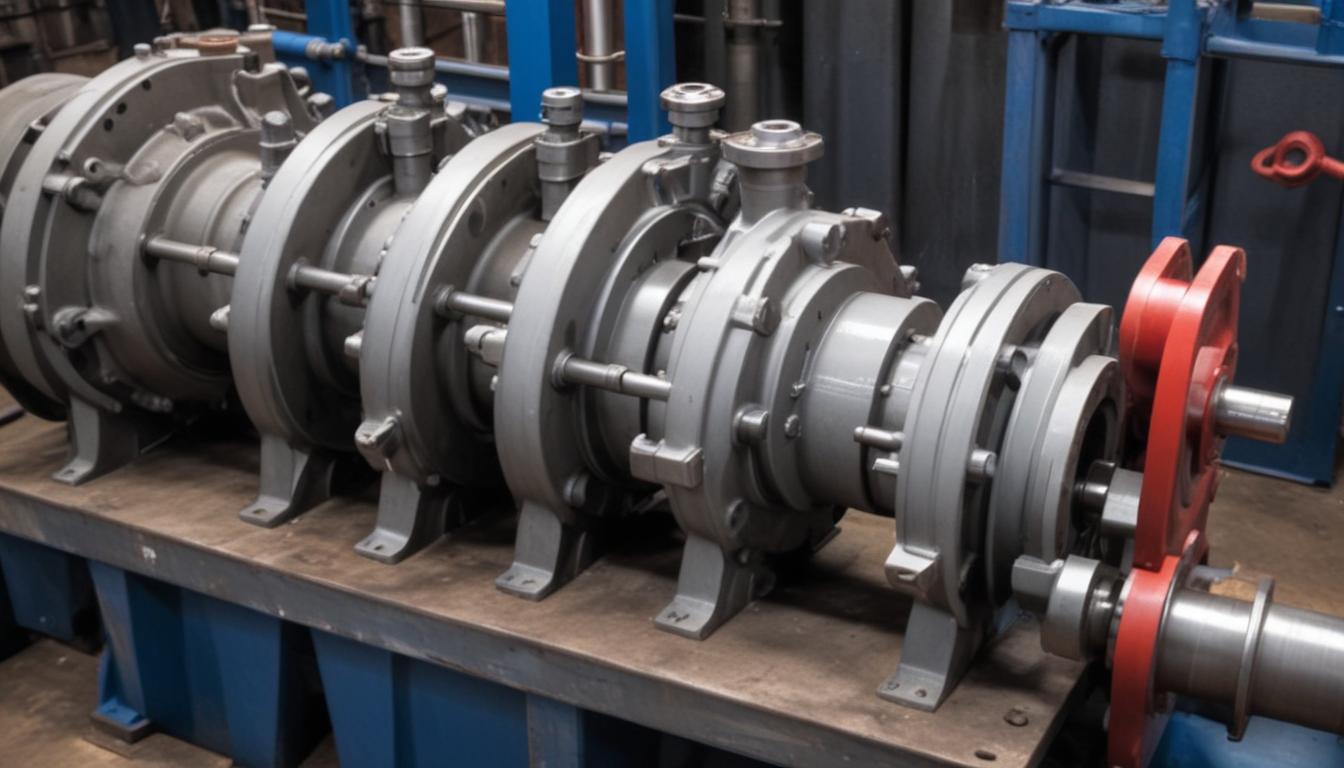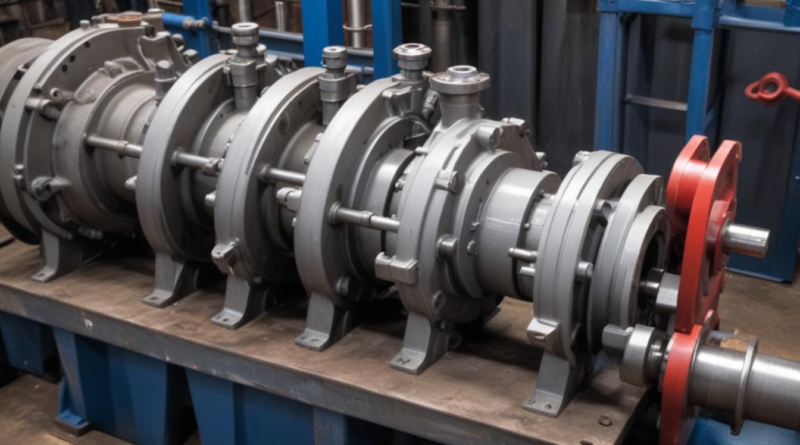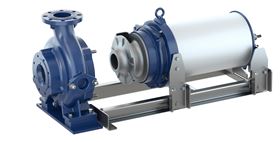how to troubleshoot pump shaft misalignment
Shaft misalignment occurs when the centerlines of two connected shafts do not coincide. In the context of a pump shaft, this misalignment can be categorized primarily into two types: parallel misalignment and angular misalignment.
- Parallel Misalignment: This type occurs when the shafts are parallel but not collinear. It typically results from lateral displacement between the pump and driver, causing increased bearing loads and potential seal failures.
- Angular Misalignment: Here, the shafts are not parallel and their axes converge or diverge at an angle. This can lead to excessive vibration, accelerated wear of coupling components, and inefficient power transmission.
Several factors contribute to shaft misalignment, including:
- Installation Errors: Improper alignment during the initial installation phase is a common cause, often due to inaccurate measurements or inadequate support structures.
- Thermal Expansion: Differential heating between connected components can cause expansion or contraction, leading to misalignment over time.
- Foundation Shifts: Settling or movement of the foundation can alter the relative positions of the pump and driver, resulting in misalignment.
- Mechanical Wear: Wear and tear of bearings, couplings, and other components can progressively lead to misalignment.
Understanding the implications of shaft misalignment is crucial for effective troubleshooting. Misalignment can lead to:
| Impact | Description |
|---|---|
| Increased Vibration | Misaligned shafts cause uneven forces during operation, resulting in excessive vibrations that can damage machinery. |
| Accelerated Wear | Components such as bearings and seals experience uneven loading, leading to premature failure. |
| Energy Loss | Inefficient power transmission due to misalignment can result in higher energy consumption and reduced system performance. |
| Operational Downtime | Frequent maintenance and repairs caused by misalignment can lead to unexpected downtime, affecting productivity. |
Properly addressing shaft misalignment involves recognizing its types, understanding the underlying causes, and comprehending its effects on the overall system. This foundational knowledge is essential for developing effective strategies to maintain optimal pump performance and longevity.
identifying signs of misalignment
Detecting shaft misalignment early is essential to prevent significant damage to the pump system and ensure uninterrupted operations. Key indicators that suggest a possible misalignment include:
- Excessive Vibration: One of the most common signs, increased vibration levels often indicate that the pump shaft is not properly aligned with the driver. These vibrations can be felt throughout the machinery and may be more pronounced at certain operating speeds.
- Unusual Noises: Grinding, whining, or knocking sounds emanating from the pump can signal misalignment. These noises are typically the result of uneven loading on the bearings and coupling components.
- Overheating Bearings: Misalignment causes uneven distribution of loads on the bearings, leading to excessive heat generation. This can reduce the lifespan of the bearings and potentially cause failures.
- Increased Wear and Tear: Visible signs of wear on coupling components, bearings, and seals can indicate ongoing misalignment issues. This wear accelerates maintenance schedules and replacement costs.
- Frequent Maintenance Requirements: An unexpected rise in maintenance activities, such as lubrication or part replacements, may be a response to underlying misalignment problems.
- Energy Inefficiency: A misaligned pump shaft can lead to inefficient power transmission, resulting in higher energy consumption and reduced overall system performance.
- Coupling Damage: Inspecting the coupling may reveal signs of distortion, cracking, or other damage caused by the misaligned shafts exerting uneven forces.
To systematically identify and evaluate these signs, the following table outlines typical symptoms associated with pump shaft misalignment and their potential implications:
| Symptom | Potential Implications |
|---|---|
| Increased Vibration | Can lead to structural damage, compromised machine integrity, and unsafe operating conditions. |
| Unusual Noises | May indicate internal component wear, requiring immediate troubleshooting to prevent failure. |
| Overheating Bearings | Shortens bearing life and can cause lubricant breakdown, necessitating frequent replacements. |
| Increased Wear and Tear | Results in higher maintenance costs and potential unscheduled downtime. |
| Energy Inefficiency | Elevates operational costs and reduces the overall efficiency of the pump system. |
| Coupling Damage | Requires coupling repairs or replacements, disrupting normal operations. |
Regular monitoring and timely identification of these signs are crucial components of effective troubleshooting. Implementing condition monitoring techniques, such as vibration analysis and thermal imaging, can aid in the early detection of misalignment issues, allowing for prompt corrective actions and minimizing the impact on the pump system’s performance and longevity.
measuring shaft alignment
Accurate measurement is paramount in identifying and addressing shaft misalignment effectively. Utilizing the appropriate techniques and tools ensures precise detection, facilitating timely troubleshooting and corrective actions to maintain optimal pump performance. The following methods are commonly employed to measure shaft alignment:
- Straight Edge and Feeler Gauge Method: This traditional approach involves placing a straight edge across the coupling and using feeler gauges to measure any gaps. While simple and cost-effective, this method offers limited precision and is best suited for basic alignment checks.
- Dial Indicator Method: This technique uses dial indicators mounted on magnetic or in-line bases to measure displacement between the pump and driver shafts. It provides higher accuracy than the straight edge method and is effective in detecting both parallel and angular misalignment.
- Laser Alignment Systems: Laser alignment tools emit laser beams to detect and quantify misalignment with high precision. These systems often include software for real-time data analysis and can streamline the alignment process, making them ideal for complex or high-precision applications.
- Autocollimator Systems: Utilizing autocollimators, this method offers exceptionally high precision in detecting minute angular misalignments. It is typically used in critical applications where even slight deviations can significantly impact performance.
Each measurement method offers distinct advantages and is chosen based on the specific requirements of the pump system and the desired level of accuracy. The table below summarizes the key features of each alignment measurement technique:
| Alignment Method | Accuracy | Ease of Use | Typical Applications |
|---|---|---|---|
| Straight Edge and Feeler Gauge | Low to Moderate | Simple | Basic installations and field adjustments |
| Dial Indicator | Moderate to High | Requires Skill | Industrial maintenance and troubleshooting |
| Laser Alignment Systems | High | User-Friendly | High-precision applications and automated systems |
| Autocollimator Systems | Very High | Complex | Critical machinery with stringent alignment requirements |
The process of measuring shaft alignment typically involves the following steps:
- Preparation: Ensure the pump and driver are clean and free from debris. Disconnect and secure any necessary components to facilitate access for measurement tools.
- Initial Assessment: Conduct a preliminary visual inspection to identify any obvious signs of misalignment or wear that could affect measurements.
- Tool Setup: Install the chosen alignment measurement tools according to the manufacturer’s instructions. This may involve mounting dial indicators, setting up lasers, or positioning feeler gauges.
- Baseline Measurements: Take initial readings to establish a baseline alignment condition. Multiple measurements may be necessary to account for different axes.
- Analysis: Compare the measurements against the manufacturer’s specifications or industry standards to determine the extent of misalignment.
- Documentation: Record all measurements and observations for future reference and to guide the adjustment process.
Accurate measurement of shaft alignment is a critical component in the effective troubleshooting of pump systems. By employing the appropriate measurement techniques and tools, technicians can precisely identify misalignment issues and implement corrective actions to ensure the longevity and efficiency of the pump shaft and associated machinery.
adjusting and correcting misalignment
 Correcting misalignment in a pump system requires a systematic approach to ensure that the pump shaft is realigned accurately with the driver. The following steps outline the process of adjusting and correcting misalignment effectively:
Correcting misalignment in a pump system requires a systematic approach to ensure that the pump shaft is realigned accurately with the driver. The following steps outline the process of adjusting and correcting misalignment effectively:
- Initial Shutdown and Safety Measures: Before commencing any adjustment, ensure that the pump and driver are completely shut down. Lockout/tagout procedures should be implemented to prevent accidental startup, ensuring the safety of personnel involved in the troubleshooting process.
- Accessing Alignment Points: Gain access to the alignment points, typically located at the base or foundation of the pump and driver. This may involve removing panels, covers, or other obstructions to reach the necessary adjustment points.
- Loosening Mounting Bolts: Gradually loosen the mounting bolts in a balanced manner. This helps in making uniform adjustments and prevents introducing additional misalignment during the process.
- Making Incremental Adjustments:
- Horizontal Adjustments: Adjust the horizontal position of the pump or driver using leveling tools or laser alignment systems. Small, incremental movements are recommended to achieve precise alignment.
- Vertical Adjustments: Utilize shims or adjustable mounts to correct any vertical discrepancies between the pump and driver. Ensuring vertical alignment is crucial to prevent excessive bearing loads.
- Real-Time Measurement and Feedback: Continuously monitor the alignment using the chosen measurement tools, such as laser alignment systems or dial indicators. Real-time feedback allows for immediate corrections and enhances the accuracy of the adjustments.
- Tightening Mounting Bolts: Once the desired alignment is achieved, progressively tighten the mounting bolts in a crisscross pattern. This ensures that the alignment remains consistent and that no new misalignment is introduced during the tightening process.
- Final Verification: After tightening, perform a final alignment check to confirm that the pump shaft is properly aligned with the driver. This may involve re-measuring using the same or additional alignment tools to ensure consistency.
- Documentation and Reporting: Record all adjustments made, including the initial misalignment measurements, the correction steps undertaken, and the final alignment results. Proper documentation aids in future troubleshooting and maintenance activities.
Implementing effective adjustment techniques is essential for mitigating the adverse effects of misalignment. The table below compares common alignment correction methods:
| Correction Method | Description | Best Suited For |
|---|---|---|
| Shimming | Involves adding or removing shims to adjust the height and position of the pump or driver. | Minor vertical and horizontal misalignments in low to medium precision applications. |
| Beam Alignment | Uses adjustable beams to facilitate precise alignment adjustments between the pump and driver. | Large machinery requiring significant alignment adjustments. |
| Adjustment of Foundation Mounts | Involves repositioning the entire foundation or base to correct misalignment. | Severe misalignment issues that cannot be resolved through local adjustments. |
| Use of Adjustable Couplings | Employs couplings with built-in adjustment capabilities to fine-tune alignment. | Dynamic systems where continuous alignment adjustments may be necessary. |
Preventive measures during the adjustment process can significantly enhance the longevity and efficiency of the pump system. Adhering to best practices such as making small, precise adjustments, using calibrated tools, and following a structured adjustment sequence can prevent the introduction of new misalignment issues.
Additionally, leveraging advanced technologies like laser alignment systems can streamline the correction process, offering high precision and reducing the likelihood of human error. Regular training for maintenance personnel on the latest alignment techniques and tools is also recommended to maintain a high standard of troubleshooting and alignment accuracy.
By meticulously following these adjustment and correction procedures, technicians can effectively address shaft misalignment, ensuring optimal performance and reliability of the pump system.
preventive maintenance strategies
Implementing effective strategies to prevent shaft misalignment is essential for maintaining the reliability and efficiency of pump systems. Proactive maintenance not only minimizes the risk of misalignment but also extends the lifespan of critical components, reducing both downtime and operational costs. The following approaches outline key preventive measures that can be integrated into regular maintenance routines:
- Regular Inspections: Conduct routine visual and instrumental inspections to identify early signs of wear, vibration, or other indicators of potential misalignment. Regular checks allow for timely intervention before minor issues escalate into significant problems.
- Proper Installation Practices: Ensure that pumps and drivers are installed according to manufacturer specifications. Accurate alignment during the initial setup lays a strong foundation, reducing the likelihood of future misalignment caused by installation errors.
- Vibration Monitoring: Utilize vibration analysis tools to continuously monitor the machine’s operational conditions. Abnormal vibration patterns can be early indicators of misalignment, enabling prompt corrective actions.
- Balanced Rotating Components: Ensure that all rotating parts, including the pump shaft and impellers, are properly balanced. Imbalances can contribute to misalignment and excessive vibration, accelerating wear and tear.
- Lubrication and Bearing Maintenance: Maintain appropriate lubrication levels and schedules for bearings and other moving parts. Proper lubrication reduces friction and wear, helping to maintain alignment over time.
- Foundation Stability: Verify that the foundation remains stable and free from shifts or settling. Any movement in the foundation can alter the alignment of the pump and driver, leading to misalignment issues.
- Environmental Controls: Control environmental factors such as temperature and humidity, which can affect the materials and components of the pump system. Thermal expansion or contraction due to temperature fluctuations can cause misalignment if not properly managed.
- Training and Education: Provide ongoing training for maintenance personnel on the latest alignment techniques and preventive maintenance practices. Skilled technicians are better equipped to identify and address potential misalignment issues effectively.
- Use of Advanced Monitoring Technologies: Implement technologies such as laser alignment systems, condition monitoring software, and automated alert systems. These tools enhance the accuracy of alignment assessments and facilitate real-time monitoring of the pump system’s health.
The table below summarizes key preventive maintenance activities, their purposes, and recommended frequencies:
| Preventive Activity | Purpose | Recommended Frequency |
|---|---|---|
| Visual Inspections | Detect early signs of wear, corrosion, and misalignment. | Monthly |
| Vibration Analysis | Identify abnormal vibration patterns indicative of misalignment. | Quarterly |
| Alignment Checks | Ensure pump and driver shafts remain properly aligned. | Bi-annually |
| Balancing of Rotating Components | Prevent imbalance-related misalignment and vibrations. | Annually |
| Lubrication Maintenance | Maintain optimal lubrication levels to reduce friction and wear. | Monthly |
| Foundation Stability Checks | Ensure the foundation remains secure and free from movement. | Annually |
| Environmental Monitoring | Control temperature and humidity to prevent thermal misalignment. | Continuously |
| Training Programs | Equip maintenance staff with up-to-date knowledge and skills. | Ongoing |
| Advanced Monitoring Implementation | Utilize technology for real-time health monitoring and alerts. | As Needed |
Adopting a comprehensive preventive maintenance plan involves integrating these activities into the regular maintenance schedule and ensuring adherence through diligent execution. Additionally, leveraging data from monitoring tools can provide valuable insights into the pump system’s performance, allowing for predictive maintenance and reducing the reliance on reactive troubleshooting.
Documentation and Record-Keeping: Maintaining detailed records of all preventive maintenance activities is crucial. Documentation aids in tracking the history of the pump system, identifying recurring issues, and refining maintenance strategies to enhance effectiveness. Records should include inspection results, maintenance actions taken, alignment measurements, and any adjustments made.
Continuous Improvement: Regularly review and assess the effectiveness of preventive maintenance strategies. Solicit feedback from maintenance personnel, analyze performance data, and stay informed about advancements in alignment technologies. Continuous improvement ensures that preventive measures evolve to address emerging challenges and incorporate best practices.
By systematically implementing these preventive maintenance strategies, organizations can significantly reduce the incidence of pump shaft misalignment, enhance operational efficiency, and ensure the longevity of their pump systems. Proactive maintenance not only mitigates the risks associated with misalignment but also contributes to overall system reliability and performance.




